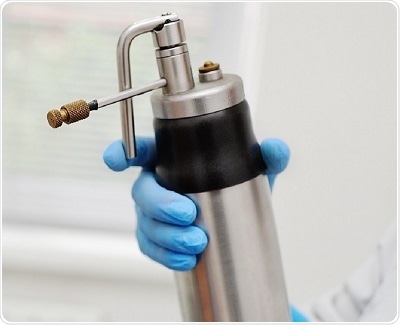By Jeyashree Sundaram, MBA
Penile Intraepithelial Neoplasia (PeIN or PIN), also known as penile squamous cell carcinoma, is a premalignant condition of the penile epithelium. The most sensitive way of detecting PeIN is by applying acetic acid to the skin of the male genitalia. The treatment procedures for PeIN include topical chemotherapy, laser therapies (Nd:YAG, and Co2), cryotherapy, photodynamic therapy, and surgical excision.
 Credit: Evgeniy Kalinovskiy/ Shutterstock.com
Credit: Evgeniy Kalinovskiy/ Shutterstock.com
Topical therapies
Topical therapy is used to treat penile lesions such as Pseudoepitheliomatous, Keratotic and Micaceous Balanitis, Bowenoid papulosis (BP), and Carcinoma in situ (CIS).
- Topical chemotherapy: Topical chemotherapy is the first-line treatment method used with a drug called 5-fluorouracil (5-FU). Clinicians have varied protocols depending on the dosage level of 5-FU. It is commonly applied topically on alternate days for 4 - 6 weeks.
During the period of treatment, the affected part becomes wadded and inflamed. Topical corticosteroids can be used additionally for the discomfort; however, reactive changes in certain regions can take four to eight weeks to heal. The number of patients cured by undergoing this type of treatment is minimal (less than ten patients).
- Topical immunotherapy: Topical immunotherapy is employed as a second-line procedure for treating partial or non-responders of PeIN with the help of 5% imiquimod cream. This treatment is applied for 46 weeks and depending upon the application, the inflammatory response of the skin is controlled. This type of topical therapy has a rate of 30% partial response and 70% complete response. After a year, no recurrence of PeIN is observed.
Laser therapy
In laser therapy, neodymium-doped yttrium aluminium garnet (Nd:YAG) and carbon-dioxide (CO2) lasers are used. This is the first-line treatment procedure that is predominantly involved in treating BP and CIS. Treatment involving these lasers has minor complications such as bleeding with a little pain at the laser ablated sites.
- CO2 laser: The CO2 laser is utilized as a scalpel to remove tissue for histological analysis through direct focusing. It has the ability to penetrate into the tissue to about 22.5 mm. The regions treated with exposure to CO2 laser take around 34 weeks to heal.
- Nd:YAG laser: The Nd:YAG laser is involved in treating larger precancerous lesions with a penetration depth of 35 mm, and the ablated region takes about 23 months to heal. But this type of laser treatment leads to coagulation of tissues and inhibits histological diagnosis, leading to complexity in understanding this type of disease.
Cryotherapy
Cryotherapy utilizes nitrous oxide or liquid nitrogen to cause tissue damage at temperatures between 20 and 50°C. Tissue damage is achieved by the development of ice crystals resulting in cell disruption and cell death. This treatment of penile lesions has a higher risk of recurrence compared with surgical excision and chemotherapy procedures.
Photodynamic therapy
Photodynamic therapy (PDT) uses a photosensitizing cream with a chemical called delta-5-aminolaevulinic acid, applied in the affected area for nearly three hours. Following the exposure of PDT light to lesions, cell death of excited cells occurs. This therapy is performed for a period of approximately 35 months.
Surgical excision
Surgical excision is the ideal procedure to treat all premalignant lesions. This procedure is recommended in patients who are unwilling to follow instructions and strict treatment protocols.
Circumcision plays a crucial role in the management of precancerous conditions. It helps in complete removal of lesions present on the foreskin and avoids HPV infection, advancement to invasive disease, and chronic inflammation. A 5% of acetic acid is smeared on the penis for about 5 min to identify the occult regions of CIS with the help of acetowhite reaction and malignant resection.
- Total glans resurfacing: This technique is executed under general anesthesia with preoperative antibiotic prophylaxis and with the help of a tourniquet device. Four regions of glans epithelium are marked and then circumcoronal and perimeatal incision is performed. Now the subepithelial tissue and glans epithelium is removed from the latent spongiosum, beginning from meatus to coronal sulcus for each quadrant.
A split-thickness skin graft taken from the thigh is utilized to protect the exposed glans. This method provides conservation of the penile form, length, and function. It also has good oncological regulation with better cosmetic appearance.
- Partial glans resurfacing: Partial glans resurfacing (PGR) is a primary surgical procedure for glanular CIS. The principle involved in PGR is the same as TGR, but it is employed in persons with localized CIS with less than 50% affected glans. PGR is related to a greater risk of positive surgical margins of 67%. Forty percent of this group needs additional surgical intervention and is without any risk of recurrence.
Another surgical procedure used for excision is Mohs micrographic surgery. This surgery helps in complete removal of a lesion in thin sections with high preservation of penile tissue. Since it is a time-consuming and difficult process associated with a recurrence rate of 32%, it is not a widely used technique.
Further Reading